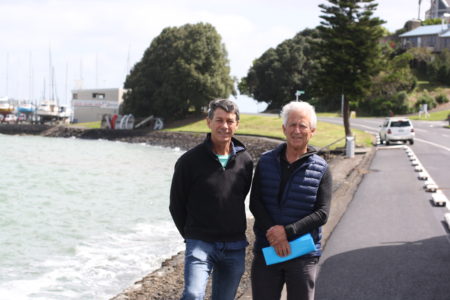
The new pedestrian pathway at Little Buckland’s Beach is causing tension as some residents suggest the money would have been better spent on the seawall restoration project.
The pathway was a Howick Local Board initiative to improve pedestrian safety by separating pedestrians from vehicle traffic with timber sleepers.
Bucklands and Eastern Beaches Ratepayers and Residents Association chair Steve Udy says the implementation of the pathway has left him questioning the dedication of the board towards fixing coastal erosion issues.
“Residents didn’t want this. They didn’t want to lose their parking spaces for a temporary pathway, they don’t want a crumbling road resealed, they want the seawall fixed,” he says.
Udy has been working in partnership with former Olympian and Bucklands Beach resident Bruce Kendall on a solution-based approach to the coastal erosion dilemma.
While the pair agree that pedestrian safety needs to be a priority, they believe the project wasn’t a safe or cost effective solution.
According to Auckland Transport the road cost $171,837 to resurface between Wharf and Laings Roads and about a further $37,000 to widen the shoulder for the pathway.
“[The pathway] starts right at the beginning of the seawall and finished at the end of the seawall and should direct you onto a footpath leading out to Grangers Point,” Udy says.
“But people continue walking up along the road because…your natural tendency is to keep walking straight rather than veering off towards the footpath. So that’s actually leading people right into a blind corner.”
Instead Udy had suggested two pedestrian crossings at either end of little Bucklands Beach which would guide pedestrians to the landward side of the road where there is a proper footpath.
“The pedestrian crossings would have been much cheaper and the money could have been spent on restoring the beach and seawall. Once the beach is fixed, as you can see in our plan for the restoration, there is space for a proper footpath that will keep people safe,” Kendall adds.
Howick local Board chair David Collings says while all options were considered, the temporary wide shoulder pathway was the best option available.
“It’s all very well for people to suggest a couple of pedestrian crossings will make people cross the road to the safe side,” he says.
“However the information we had indicated that this would not happen and of course it is a no-brainer that people prefer to walk along the beach side of the road.”
Collings says the board is still committed to solutions that the community prefers, but it can’t ignore community safety.
“Whether we like it or not, that people walk on [the seaward] side of the road we must put lives at the top of our list when making such decisions.”
Udy and Kendall argue that the pathway was an expensive option which does not guarantee pedestrian safety, and doesn’t comply with Auckland Transport’s code of compliance.
“A footpath on top of a seawall is supposed to have building consent plus it’s supposed to have a safety railing,” Udy says.
“But now they’ve said we consulted on a walkway not a footpath. They’re using semantics. They’re saying a walkway doesn’t have to comply because it’s only temporary.”
Auckland Transport spokesperson, Mark Hannan says widening the shoulder was never intended to be a fully formed footpath, but instead a safe way to give people more space to walk on the seaward side of the road.
“The reason why a ‘footpath’ was not built is that it is very expensive to build a fully functional ‘footpath’ and as the seawall will be rebuilt relatively soon any new ‘footpath’ would have a very short life.”
Hannan says the seawall is currently scheduled to be rebuilt in the early 2020s, but it’s being carefully monitored and will be rebuilt sooner if the need arises.
“Auckland Transport agrees that this area needs to be re-developed and are contributing to Auckland Council and Howick Local Board plans for the area,” he says.
While Hannan says it is uncertain how long the temporary pathway will be in place, AT is taking any residents’ concerns very seriously.
“We are listening to the community and will do safety review of the project to see if we should install a hand rail along the seawall or make any other modifications.”









